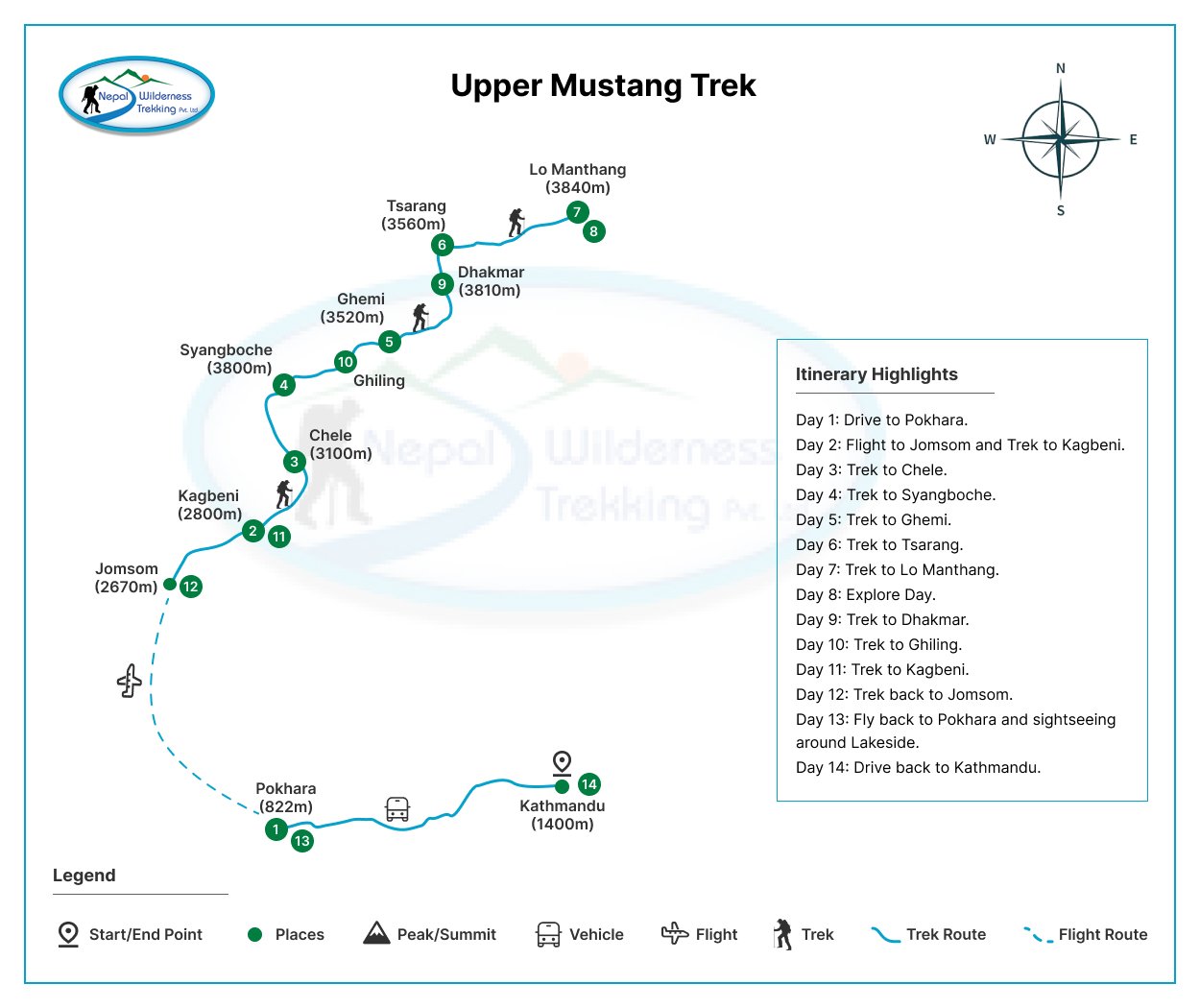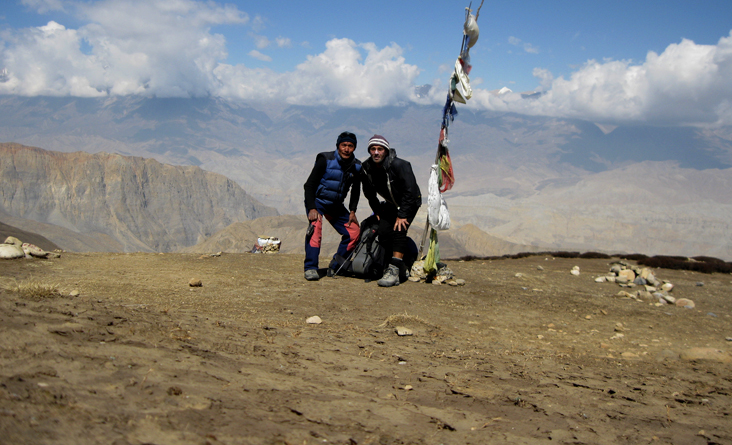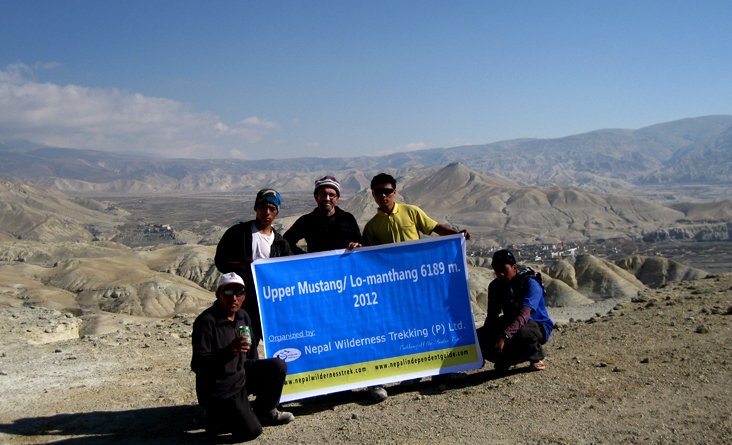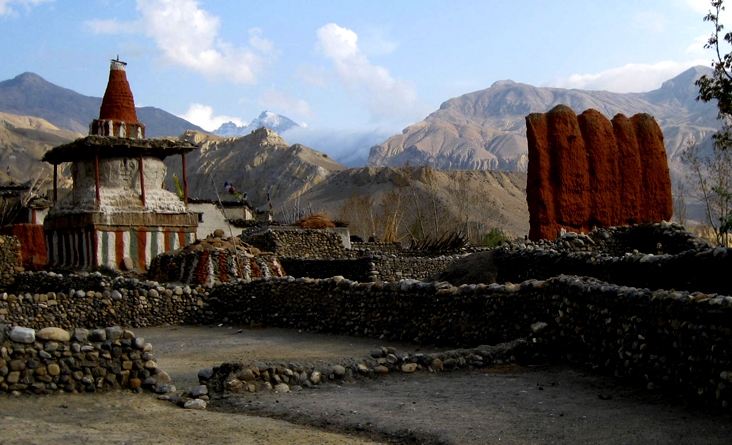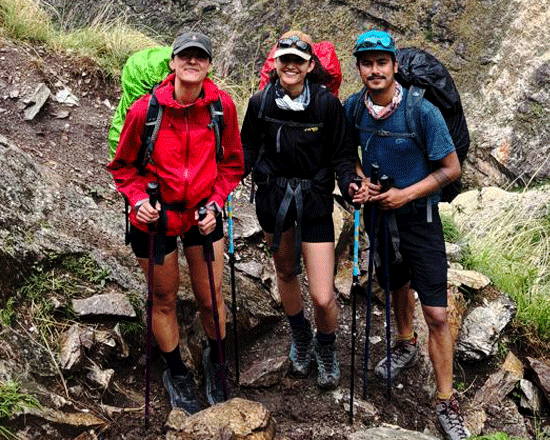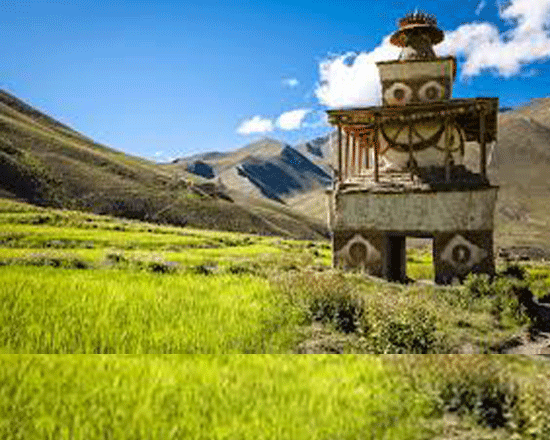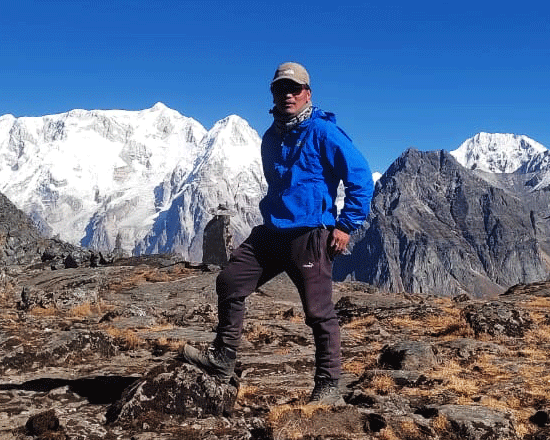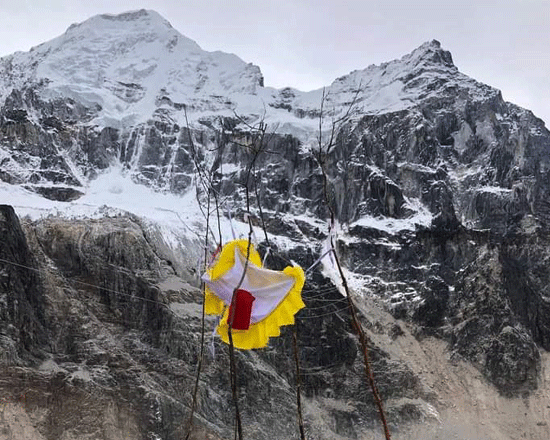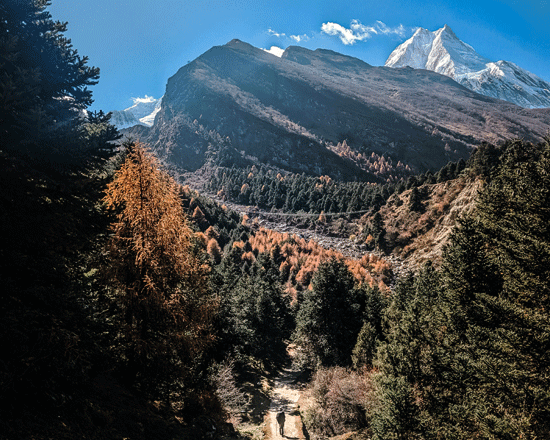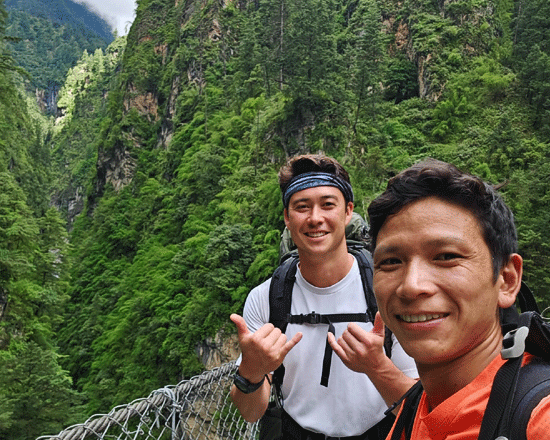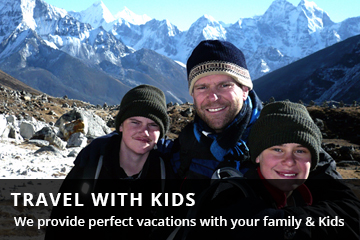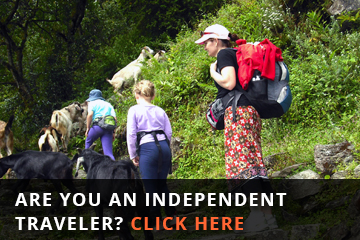Upper Mustang Trek
Upper Mustang Trek
Wilderness TrekkingTrip Facts
Since the terrain can be hard and the days long, hikers on these treks should be in good physical condition and have some previous mountain walking experience. Steep climbing may be involved, although it is never necessary to use ropes. Treks at this level can he arranged for periods of 16 to 21 days. Typically, a gradual ascent through a green river valley will lead you up to a number of high passes, where you will reach the altitude of 5416m. Often times, you will get a close insight into the Tibetan culture. Participants should expect to trek above 5416m/17872ft.
Mode of Travel : Flight/Land100%
Overview
The Upper Mustang Trek 14 Days Package Itinerary
The Upper Mustang Trek offers a remarkable journey into Nepal’s hidden valley, combining extraordinary Himalayan scenery with deep cultural history. This adventure leads through desert-like terrain sculpted by deep canyons, eroded cliffs, and vivid rock formations. Snow-capped peaks of the Annapurna and Dhaulagiri ranges contrast beautifully against the arid landscape. Trekking alongside the Kali Gandaki River, one of the world’s deepest valleys, adds to the visual splendor.
This trek presents a rare opportunity to explore Upper Mustang’s famed cave complexes, carved into sheer cliffs and used for centuries as burial chambers, meditation sanctuaries, and homes. Notably, the Chhoser Cave near Lo Manthang showcases an elaborate network of rooms and staircases. Archaeological discoveries here include ancient manuscripts and relics that shed light on the region’s early civilization.
Upper Mustang’s desert beauty, once cut off from the outside world, reveals a region that has preserved its history in isolation. Caves like Chhoser’s offer a vivid look into Mustang’s mystical past. The landscape, shaped by millennia of erosion, is stark yet stunning, offering an unforgettable trekking experience.
Vegetation is sparse here, with the Bhote pipal tree being the most common. Its yellow leaves and drought-resistant nature make it invaluable for construction in this challenging environment, where wood is a scarce resource.
Exploration of the Upper Mustang Forbidden Kingdom
The Upper Mustang Trek grants access to a once-restricted area, opened only in 1992. Known as the “Forbidden Kingdom” due to geographic and political isolation, it has retained a pure Tibetan cultural identity. This seclusion has protected Mustang’s ancient customs, language, and lifestyle, offering trekkers a rare glimpse into an untouched society.
Travelers are drawn by the region’s preserved monasteries, spiritual rituals, and dramatic landscapes. With timeworn traditions still vibrant today, Upper Mustang feels like a living museum—a rare bridge between ancient and modern worlds.
Cultural Immersion of the Upper Mustang Trek
This trek is a cultural journey through the homes and traditions of the Thakali and Tibetan Gurung people. Strongly influenced by Tibetan Buddhism, you’ll witness sacred monasteries, prayer wheels, and ancient murals. The people of Mustang, known as the Loba, warmly welcome travelers and proudly maintain their heritage. Many still display portraits of the former king and queen as a mark of deep respect.
The Upper Mustang Trek is a cultural odyssey into a society where Tibetan customs, dialects, and architecture have thrived untouched for generations.
Cultural Preservation
Upper Mustang’s architectural beauty lies in its whitewashed homes, red-walled gompas, and prayer flags fluttering across the barren landscape. Ancient rituals and dialects endure, forming the cultural backbone of this remote area. Tourism here supports the preservation of these traditions by encouraging sustainable practices and boosting the local economy.
Trekkers experience firsthand the living culture of Mustang while helping protect it for future generations.
Upper Mustang Trek Map
The Upper Mustang Trek typically starts with a flight from Pokhara to Jomsom. From there, the trail passes through Kagbeni, gateway to Upper Mustang, before continuing to Lo Manthang. The itinerary usually spans 10 to 14 days, depending on side trips and time spent in key locations.
This route connects with Lower Mustang and Muktinath and can also be linked to the Annapurna Circuit via Thorong La Pass.
Upper Mustang Trek Difficulty
The Upper Mustang Trek is of moderate difficulty. Key considerations include:
-
Altitude: Lo Manthang sits at 3,800 meters. Though lower than Everest trails, proper acclimatization is crucial to avoid altitude sickness.
-
Terrain: Arid, rocky, and exposed, the trail involves steady climbs and descents. Strong winds can make walking difficult, but trails are well-marked.
-
Climate: Harsh weather and strong sun due to high elevation and lack of vegetation can be challenging.
-
Fitness: Trekkers should be reasonably fit to handle 5–7 hours of daily hiking.
-
Amenities: Facilities are basic but comfortable; expect a more remote and rustic trekking experience.
Lo Manthang – The Ancient Capital
Lo Manthang, the walled capital of the ancient Kingdom of Lo, retains its medieval atmosphere. Built in the 15th century, it houses iconic monasteries like Thubchen Gompa and Jampa Lhakhang, as well as the former royal palace. Though the monarchy officially ended in 2008, locals still revere the king.
Lo Manthang’s preserved architecture, cultural heritage, and spiritual ambiance make it the soul of the Upper Mustang Trek.
The Tiji Festival of Mustang
Held annually in Lo Manthang over three days in late April or early May, the Tiji Festival celebrates Tibetan Buddhist legends of good triumphing over evil. Masked dances, rituals, and prayer ceremonies draw visitors and locals alike. Observing this festival adds deep spiritual and cultural insight to the trek.
Natural Splendors
Upper Mustang’s rain shadow location creates dry, windswept terrain similar to the Tibetan Plateau. Despite its barren look, the area features remarkable natural wonders: the world’s deepest gorge, unique rock formations, and ancient fossils. The trek reveals the powerful forces of nature and time.
Farming Crops in Mustang
Farming in Mustang includes high-altitude crops such as barley, buckwheat, potatoes, apples, and apricots. Farmers use sustainable methods to adapt to the challenging environment, preserving traditional agricultural practices while supporting the region’s food supply.
Authentic Tea Houses and Hospitality
Tea houses along the trail offer trekkers warm hospitality, local food, and a cozy place to rest. Sharing meals and stories with locals and fellow trekkers enhances the authentic trekking experience.
Lo Manthang Side Trip
A rewarding side trip from Lo Manthang takes you through high plateaus where yaks and horses graze, evoking the Upper Dolpo region. Adventurers can also reach the Kara La Pass—just four hours away by motorbike—on the border with China, adding excitement and altitude to the experience.
Journey to Kagbeni: Connecting Lower Mustang and Thorong La Pass
The Upper Mustang Trek begins with a flight from Pokhara to Jomsom Airport, followed by a trek to Kagbeni via the world’s deepest gorge in Thak Khola. This area forms the bridge between Lower Mustang, the sacred site of Muktinath, and the broader Annapurna region.
Holy Lake Damodar Kunda
Damodar Kunda, 40 km from Lo Manthang, is a sacred lake known for spiritual meditation. Some report sightings of meditating yogis. This destination enhances the Upper Mustang Trek by offering both spiritual depth and scenic beauty. It also serves as a route toward Nar and Phu villages via the Saribung Pass.
Best Season for the Mustang Trek
The Upper Mustang Trek is ideal from May to October—Nepal’s monsoon season—due to the rain shadow effect. This also applies to Upper Dolpo and the Annapurna Circuit. It can be combined with other treks by crossing Thorong La Pass or trekking counter-clockwise.
Responsible Trekking
Nepal Wilderness Trekking operates the 14-day Upper Mustang Trek with a focus on eco-friendly and culturally respectful practices. Our expert guides ensure safety while promoting Leave No Trace principles to protect the fragile environment and support local communities.
Upper Mustang Trek Permit Cost Details
-
Annapurna Conservation Area Permit (ACAP): USD 30
-
Trekkers’ Information Management System (TIMS) Card: USD 20
-
Restricted Area Permit (RAP): USD 500 for 10 days; USD 50/day beyond
Permits require your passport, visa, photos, and documents. Authorized permit offices include the Department of Immigration in Kathmandu, the Pokhara immigration office, and registered trekking agencies.
Conclusion
The Upper Mustang Trek is a transformative experience through the heart of a forgotten kingdom. Let Nepal Wilderness Trekking guide you on this journey of discovery through timeless villages, breathtaking landscapes, and rich culture. Our dedicated team ensures your safety, comfort, and a memorable adventure.
Note
All Upper Mustang Trek departures are guaranteed. If listed dates don’t match your schedule, we’ll tailor a trip that does. Share your dream itinerary, and we’ll make it a reality.
Detail Itinerary
- Day 1: Fly from Pokhara to Jomsom (2,720m) & Trek to Kagbeni (2,800m)
Flight Duration: 20–25 minutes
Trek Duration: 3 hours
Early in the morning, take a scenic mountain flight from Pokhara to Jomsom, offering panoramic views of the Dhaulagiri, Nilgiri, and Annapurna ranges. After a quick breakfast in Jomsom, trek along the windswept Kali Gandaki riverbed to Kagbeni, a picturesque medieval village with narrow alleys, red-walled monasteries, and apple orchards. Overnight in Kagbeni.
Restricted Area Permit checkpoint at Kagbeni.
- Day 2: Kagbeni to Chele (3,050m)
Trek Duration: 5–6 hours
After registering permits, the trail enters Upper Mustang proper. Pass through the culturally rich village of Tangbe, characterized by whitewashed houses, chortens, and narrow alleys. Continue to Chhusang, then cross the Kali Gandaki River to reach the village of Chele, perched dramatically on the cliffside.
Overnight in Chele.
- Day 3: Chele to Syanbochen (3,475m)
Trek Duration: 6–7 hours
A challenging but rewarding day. Ascend steeply to Taklam La Pass (3,624m) and Dajori La (3,735m), offering views of Tilicho and Damodar Himal. Walk past caves, unique rock formations, and remote seasonal settlements. Lunch at Samar village, before a gentle climb through juniper forests leads you to Syanbochen.
Overnight in Syanbochen.
- Day 4: Syanbochen to Ghami (3,520m)
Trek Duration: 5–6 hours
Continue uphill to cross the Yamda La (3,850m) and later the Nyi La Pass (4,010m), one of the highest points on the trek. The landscape transitions into barren hills and ochre-colored cliffs. Descend to the whitewashed village of Ghami, home to the longest mani wall in Mustang.
Overnight in Ghami.
- Day 5: Ghami to Charang (3,570m)
Trek Duration: 4–5 hours
A short trek through rugged terrain and ancient mud villages. After crossing the Ghami Khola, continue to Charang, one of the oldest and largest settlements in Mustang. Visit the 400-year-old monastery and the crumbling red-walled dzong (fortress).
Overnight in Charang.
- Day 6: Charang to Lo Manthang (3,810m)
Trek Duration: 4–5 hours
Cross the Lo La Pass (3,950m), with stunning views of the Lo Manthang valley and snow-capped mountains. Descend gently to reach the legendary walled city of Lo Manthang, the capital of the former Kingdom of Mustang.
Overnight in Lo Manthang.
- Day 7: Explore Lo Manthang & Chhoser Cave Monasteries (3,810m)
Spend the day exploring ancient Buddhist monasteries, including Jampa Lhakhang, Thubchen Gompa, and the Royal Palace. Optional excursion by jeep or horseback to Chhoser, where you’ll visit the sky caves and centuries-old Nyphu and Garphu Gompa.
Overnight in Lo Manthang.
- Day 8: Lo Manthang to Yara (3,650m)
Trek Duration: 6–7 hours
Depart from Lo Manthang through lesser-trekked territory with spectacular views and desert cliffs. Descend to the village of Dhi, cross the river, and ascend to Yara. This region is known for its unique cliff caves and fossil-rich terrain.
Overnight in Yara.
- Day 9: Excursion to Luri Gompa & Return to Yara (3,900m)
Trek Duration: 4–5 hours
A day trip to the remote and sacred Luri Gompa, tucked inside a cliff and decorated with ancient Tibetan murals and artifacts. This 13th-century cave monastery is a spiritual highlight of the trek. Return to Yara by evening.
Overnight in Yara.
- Day 10: Yara to Tangge (3,240m)
Trek Duration: 7–8 hours
One of the longest and most remote trekking days. Cross the Dhechyang Khola and climb rugged desert hills to reach the hidden village of Tangge, known for its many chortens and traditional stone-built houses.
Overnight in Tangge.
- Day 11: Tangge to Chhusang (2,980m)
Trek Duration: 8–9 hours
Start early for a tough ascent over Pha Pass (approx. 4,050m). After enjoying views of Upper Mustang and the Dhaulagiri range, descend to Chhusang. A long and scenic day on a lesser-used route with wild, remote beauty.
Overnight in Chhusang.
- Day 12: Chhusang to Muktinath (3,800m)
Trek Duration: 6–7 hours
Climb gradually via Tetang, an ancient fortified village, and reach the sacred pilgrimage site of Muktinath. Visit the Muktinath Temple complex, sacred to both Hindus and Buddhists, where natural gas flames burn eternally beside water spouts.
Overnight in Muktinath.
- Day 13: Muktinath to Jomsom (2,720m)
Trek Duration: 5–6 hours
Descend through the traditional village of Jharkot, known for its beautiful monasteries and herbal medicine schools. Follow the trail down to Jomsom along the Kali Gandaki River.
Overnight in Jomsom.
- Day 14: Fly from Jomsom to Pokhara
Take an early morning flight back to Pokhara. Enjoy your final aerial views of Mustang and the Annapurna ranges.
End of Trek.
Cost Included
- Three delicious meals per day (breakfast, lunch, and dinner) selected from the menu, including Italian, Chinese, Nepali, Indian, and various European cuisines.
- Clean and comfortable lodge accommodations during the trek.
- Government-licensed, English-speaking trekking guide with in-depth knowledge of the region.
- One porter for every two to three participants. (Note: Additional charges apply for solo clients requesting a porter.)
- All expenses for the guide and staff, including food, accommodation, salary, insurance, equipment, and domestic flights.
- Round-trip Pokhara–Jomsom–Pokhara flight tickets.
- Taxi transfers to and from the domestic airport in Pokhara.
- Special Mustang permit.
- ACAP (Annapurna Conservation Area Project) permit.
- TIMS (Trekkers’ Information Management System) card.
- First aid medical kit.
Cost Excluded
- Meals and accommodations in Kathmandu and Pokhara.
- All beverages (alcoholic and non-alcoholic), including soft drinks like Coke, Fanta, mineral water, tea, coffee, and beer.
- Personal travel insurance.
- Emergency rescue operations if required.
- International airfare.
- Nepal tourist visa fee ($25 for 15 days, $40 for 30 days for multiple-entry visas).
- Tips for the guide and porter.
- Any other costs not mentioned under “Cost Included.”
- Additional expenses or delays due to unforeseen circumstances beyond the company’s control, such as landslides, bad weather, changes in government regulations, health issues, itinerary changes for safety reasons, strikes, etc.
Trip Map
